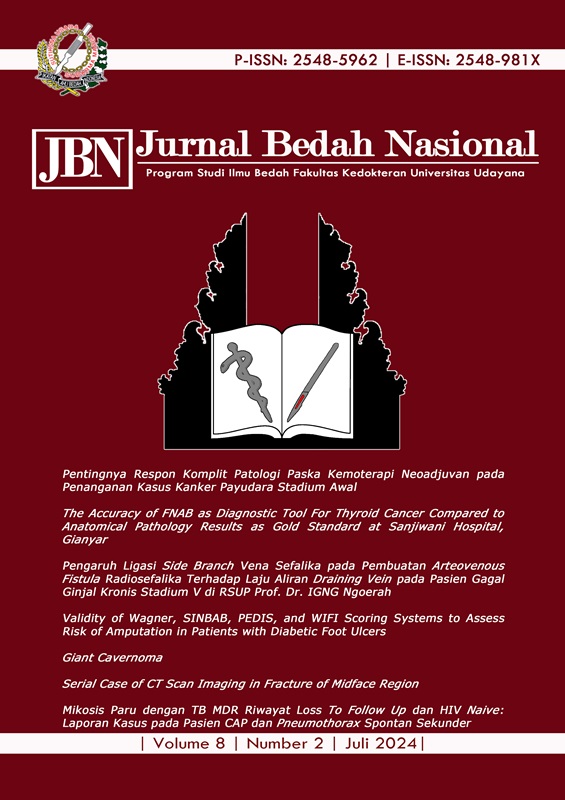Validity of Wagner, SINBAB, PEDIS, and WIFI Scoring Systems to Assess Risk of Amputation in Patients with Diabetic Foot Ulcers
Abstract
Aim: This study aims to determine validity of the Wagner, SINBAD, PEDIS, and WIFI scoring systems in assessing the risk of amputation in patients with diabetic foot ulcers at Prof. dr. I.G.N.G. Ngoerah General Hospital, Denpasar. Methods: This research is an observational study of diagnostic tests with a cross-sectional design. The sample in this study was selected by consecutive sampling from 1 January 2022 to 31 December 2022 with total of 72 respondents.Results: Wagner score test obtained sensitivity 77.2%, specificity 80.0%, PPV 93.6%, NPV 48%, accuracy 77.7%, and RR 1.8. PEDIS score test results obtained sensitivity 82.5%, specificity 86.7%, PPV 95.9%, NPV 56.5%, accuracy 83.3%, and RR 2.2. The results of the SINBAD test score obtained sensitivity 78.9%, specificity 66.7%, PPV 90.0%, NPV 45.5%, accuracy 76.3%, and RR 1.6. WIFI score test obtained sensitivity 89.5%, specificity 66.7%, PPV 91.1%, NPV 62.5%, accuracy 84.7%, and RR 2.4. Conclusion: The WIFI score has better sensitivity and accuracy compared to score Wagner, SINBAD, and PEDIS so it is recommended to use the WIFI score to assess the risk of amputation in diabetic foot ulcer patients.
Downloads
References
2. Andrisha NH, Savitri PM, Bustamam N. Hubungan antara Jumlah Sesi Terapi Oksigen Hiperbarik sebagai Terapi Adjuvan dengan Perbaikan Ulkus Kaki Diabetik di Rumah Sakit Angkatan Laut Dr. Mintohardjo Tahun 2016–2018. Jurnal Penyakit Dalam Indonesia. 2020;7(2):117.
3. International Diabetes Federation. IDF Diabetes Atlas. 8th Edition. International Diabetes Federation; 2017.
4. International Working Group on the Diabetic Foot (IWGDF). Guidelines on the Prevention and Management of Diabetic Foot Disease. International Working Group on the Diabetic Foot; 2019.
5. Sudoyo AW, Setiyohadi B, Alwi I, et al. Buku Ajar Ilmu Penyakit Dalam Jilid III. Edisi VI. Jakarta: Interna Publishing; 2014.
6. Jeon BJ, Choi HJ, Kang JS, et al. Comparison of Five Systems of Classification of Diabetic Foot Ulcers and Predictive Factors for Amputation. Int Wound J. 2017;14(3):537-545.
7. Vanherwegen AS, Lauwers P, Lavens A, et al. Sex Differences in Diabetic Foot Ulcer Severity and Outcome in Belgium. PLoS ONE. 2023;18:1-13.
8. Yusuf S, Okuwa M, Irwan M, et al. Prevalence and Risk Factor of Diabetic Foot Ulcers in a Regional Hospital, Eastern Indonesia. Open Journal of Nursing. 2016;06(1):1-10.
9. Al-Rubeaan K, Al Derwish M, Ouizi S, et al. Diabetic Foot Complications and Their Risk Factors from a Large Retrospective Cohort Study. PLoS One. 2015;10(5):e0124446.
10. Zheng Y, Ley SH, Hu FB. Global Aetiology and Epidemiology of Type 2 Diabetes Mellitus and Its Complications. Nat Rev Endocrinol. 2018;14(2):88-98.
11. Shin JY, Roh SG, Sharaf B, et al. Risk of Major Limb Amputation in Diabetic Foot Ulcer and Accompanying Disease: A Meta-Analysis. J Plast Reconstr Aesthet Surg. 2017;70(12):1681-1688.
12. Chuan F, Tang K, Jiang P, et al. Reliability and Validity of The Perfusion, Extent, Depth, Infection and Sensation (PEDIS) Classification System and Score in Patients with Diabetic Foot Ulcer. PLoS One. 2015;10(4):e0124739.
13. Darling JD, McCallum JC, Soden PA, et al. Predictive Ability of The Society for Vascular Surgery Wound, Ischemia, and Foot Infection (WIFI) Classification System After First-Time Lower Extremity Revascularizations. J Vasc Surg. 2017;65(3):695-704.

This work is licensed under a Creative Commons Attribution 4.0 International License.
Program Studi Ilmu Bedah Fakultas Kedokteran Universitas Udayana. 
This work is licensed under a Creative Commons Attribution 4.0 International License.






